An Introduction to Digital Marketing for SaaS
SaaS is one of the fastest-growing industries. Its market size has the potential to reach $171 billion by 2022:

Needless to say, proper marketing is what can help you remain relevant in this industry.
But what does SaaS marketing include? What are its peculiarities? Which strategies can help you outrun competitors? Which KPIs and metrics to track? And what mistakes should you avoid?
Here’s our introduction to SaaS marketing to get all these questions answered.
What is SaaS?
SaaS, or Software as a Service, is a product distribution model according to which a company licenses and sells software on a subscription basis and centrally hosts it.
Sounds too complicated?
When you purchase SaaS products, you buy a plan or a subscription, but you don’t become the product’s actual owner. Instead, the software provider stores all your data, manages all product updates, and offers customer service if you experience any malfunctions.
Do SaaS businesses need marketing?
Now, as we’ve figured out what a SaaS business does, let’s define SaaS marketing and decide on its place in developing a SaaS product.
SaaS marketing is a type of B2B marketing that involves strategies and tactics to build awareness around software to improve sales.
For an inexperienced SaaS brand owner, investing in marketing might not seem necessary. After all, if you have enough connections, by word of mouth, your future customers will eventually find you.
Indeed, word-of-mouth can help a SaaS business get things rolling. But you shouldn’t count on it so much, considering that you might have a handful of competitors. Marketing is a more reliable way to make good progress, especially for startups.
Here are a few other reasons why you should invest in SaaS marketing
- More opportunities to target your audience. Your LinkedIn connections might recommend your software to others, but how do you know each promotion reaches the right kind of customer? With marketing, you’re in control of the situation, which can save you both time and money (if you choose the right audience, of course).
- An organic way to nurture leads. A SaaS marketing strategy implies the development of an entire lead generation funnel, from generating a lead to converting them into a customer. If you pick the right lead nurturing tactics, you will end up with loyal returning customers.
- Better brand awareness. SaaS companies get clients not only through recommendations and customer testimonials but through online promotions as well. It’s common to use online ads, social media, and other online marketing strategies to get more people talking about your product.
To cut a long story short, you need marketing to stand out in a saturated market. B2B companies always take a brand’s marketing strategy into account before making a purchasing decision. Neglecting marketing is the same as forsaking your online image.
What makes SaaS marketing different?
You might be confused right now – since SaaS marketing involves many general digital marketing tactics, how is it different?
First and foremost, when you market SaaS products, you bet on the information. As one of your tasks is raising brand awareness and gaining authority in your industry, all content you produce should, either directly or not, provide information on your product’s value and advantages.
Next, speaking in marketing terms, a SaaS sales cycle is shorter than a usual B2B cycle. SaaS brands don’t usually invest in overly time-consuming sales strategies. Take free trial emails, for example—if a customer shows no interest in switching to a paid plan, they will no longer receive other emails.
The same goes for webinars and other events. A SaaS business usually holds an educational workshop that features the product and shows its value, but it won’t force it on a customer.
Another distinctive feature is that most customers will stay with you long-term. A basic SaaS product subscription is one month, but most consumers invest in lasting partnerships to save money. That’s why it is crucial to invest in customer retention, which you can’t do without marketing.
Finally, marketing for SaaS doesn’t just involve content promotion. Rather, you promote your entire business as a service. After all, you’ll be the one working on updates, securing the customer’s app data, providing customer service, and so on. These things will also impact your marketing strategy.
Top 6 Best Marketing Strategies for SaaS products
Even though SaaS marketing is different from the techniques a B2C brand would use, there are still quite a few versatile strategies at your disposal. Let’s take a look at them and unearth a few examples for inspiration.
1. Free trials and freemiums
It’s usual for a SaaS business to include a free trial or a freemium into a marketing plan. But what is the difference between the two?
A free trial is a tactic of offering a product to a customer for free for a short period of time.
In a freemium, a product is provided for free for an unlimited time with limited features. If you need access to more advanced perks, you have to switch to a paid plan.
Both strategies have one goal—to let a customer try a product and decide whether they are interested in proceeding with it.
If you’re looking for freemium examples, consider Postoplan. Its free plan allows access to the basic social media platforms, like Facebook and Twitter, but if you want to connect to Instagram as well or need unlimited access to Social Inbox, you’ll have to upgrade:
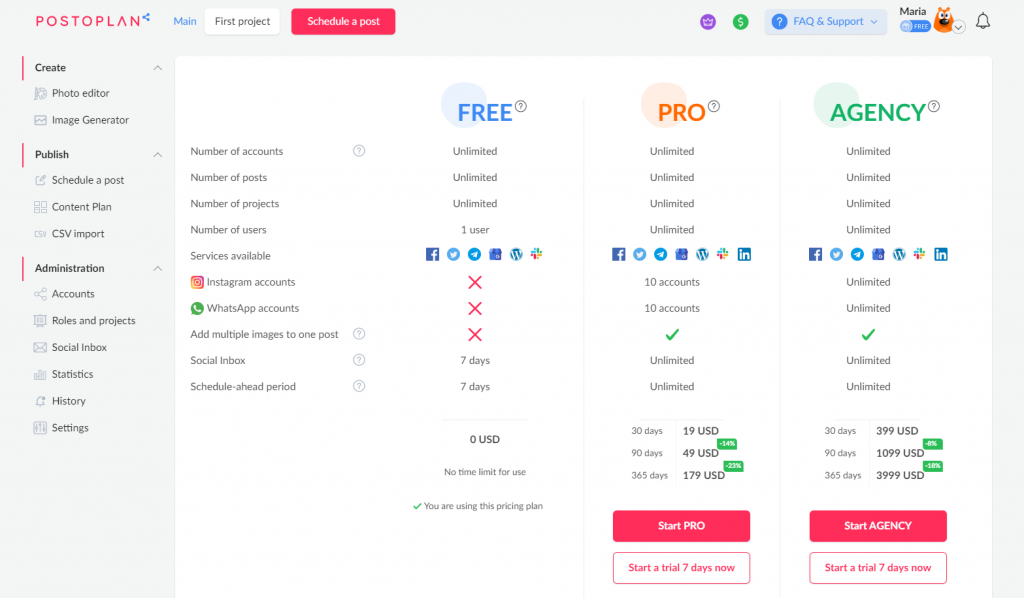
As you see, a customer with basic social media needs can stay on a free plan for as long as they want. It’s a win-win – you get a lead to nurture, and a customer gets to try and test your product for as long as they wish.
Now, what about a free trial? Hootsuite (another social media tool) uses this tactic. You can check absolutely any plan for free for 14 days, but you’ll have to provide credit card details upfront:
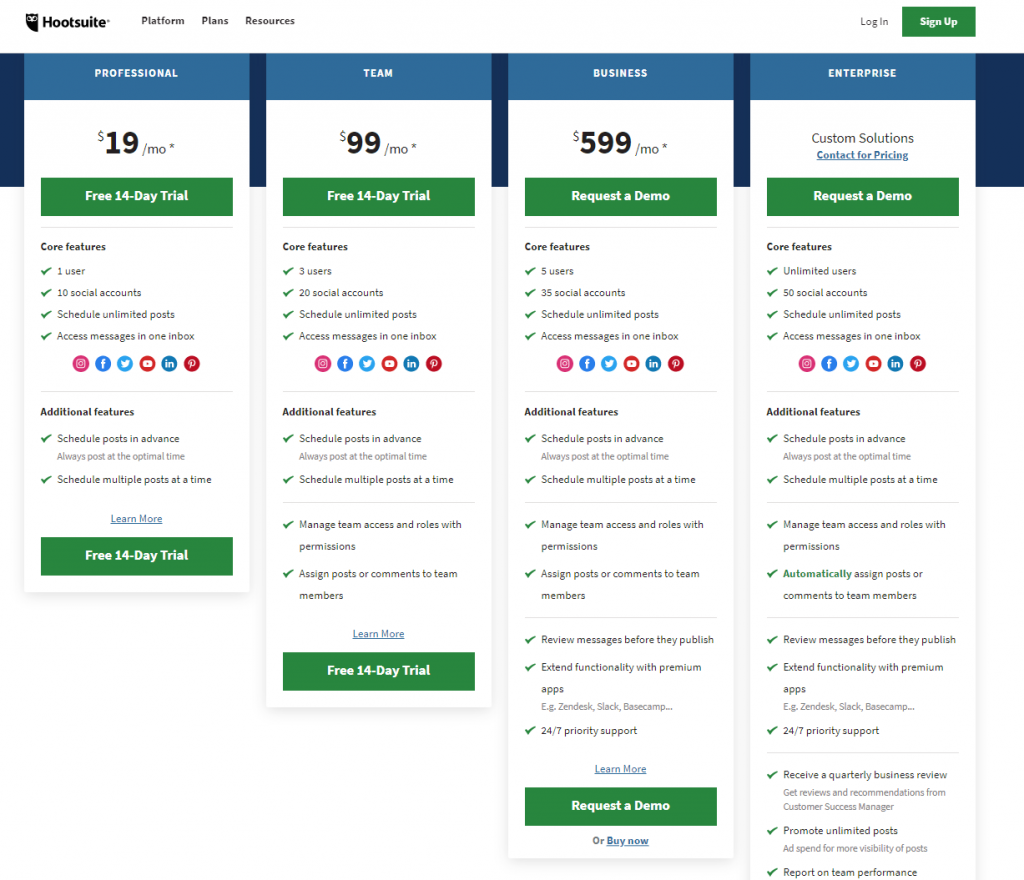
With a free trial, in most cases, you get access to the entire product and its functionality, and get to experience it for a limited time.
Now, which strategy is better?
It depends on the product, but there are more advantages to a freemium than a free trial.
Consider this: if your software is rather complex, a seven- or fourteen-day trial might not be enough to experience it in its entirety.
Another instance is the pre-set time limit is not enough to check out all the features of your product and see a tangible result. You can fix this if you extend the free trial period to one month.
Conversely, your free trial can also give away too many valuable features, which is why a customer might not be interested in paying more. The same can happen with a freemium, so place the limit on the features wisely.
Essentially, both are viable B2B marketing strategies. You can give each of them a try and choose the one to which your audience responds better.
2. Product demo
Some SaaS businesses only agree to give a sneak peek into a product via a demo. A product demo is a meeting during which a company representative showcases the product’s potential to a customer.
Product demos have a few great perks:
- You get to prove your product’s value.
- A customer has an opportunity to ask questions directly.
- You build recognition by associating the product with your brand.
- You have a chance to assuage any doubts or concerns right away.
A product demo usually stands at the beginning of a marketing funnel, similar to a free trial or a freemium. Wishpond uses a demo CTA to encourage potential customers to move forward with the purchase after checking out the product landing page:
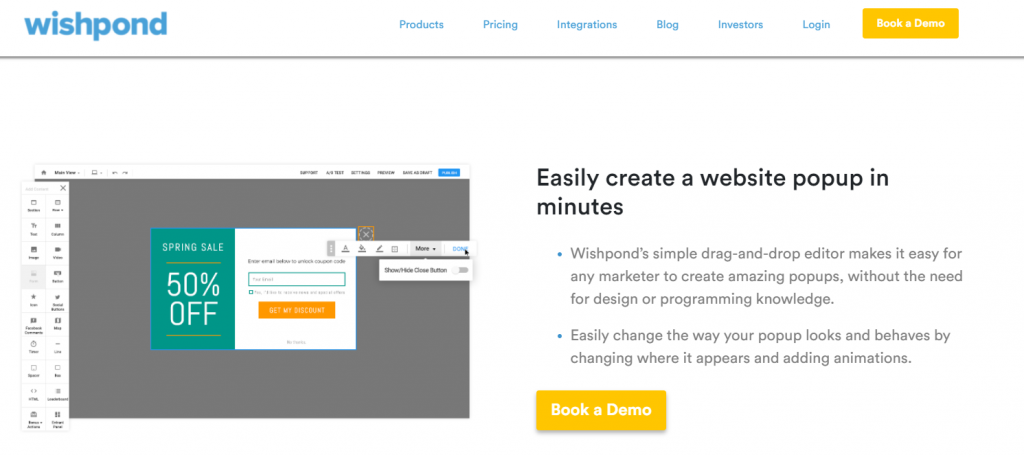
Which tactic should you choose, a freemium, a free trial, or a product demo?
Go for a product demo if you don’t want to spend time on qualifying leads. When a consumer applies for a demo, they usually have to fill out a contact form with the details that either match your customer profile or not. If they do, you can move forward with the demo and turn a qualified lead into an opportunity. Thus, a demo is your chance to convert a lead into a paying customer.
3. PPC campaigns
Today, you will hardly find a business that hasn’t tried online ads. And why not? After all, it is the easiest way to get your brand and product noticed.
Now, there is nothing different about SaaS advertising. A perfect SaaS ad campaign should be based on three major components:
- the right channel
- a well-defined target audience
- an engaging piece of content
Digital advertising for SaaS can also take many forms. One of the common ways to use PPC ads is to retarget potential buyers based on their previous behavior. For instance, if you visit SEMrush’s website, you’re likely to see its ad on Google partner websites telling you about all the benefits of its product:

PPC campaigns are also an effective strategy to generate leads. But be careful – an online ad can cost you an arm and a leg if you don’t know how to do the bidding and pick the right keywords. So, enter the game with a minimum budget just to test the waters, especially if you’re running a SaaS startup.
4. SaaS review sites
Another strategy to get people buzzing is to market SaaS software on the respective review websites. Here’s how it works: you register on a website and add your product. Next, the website reviews your submission and adds it to the featured products if everything is in order.
Here’s a list of websites for consideration:
Take a look at what a typical software review looks like (Mailchimp’s example from G2):
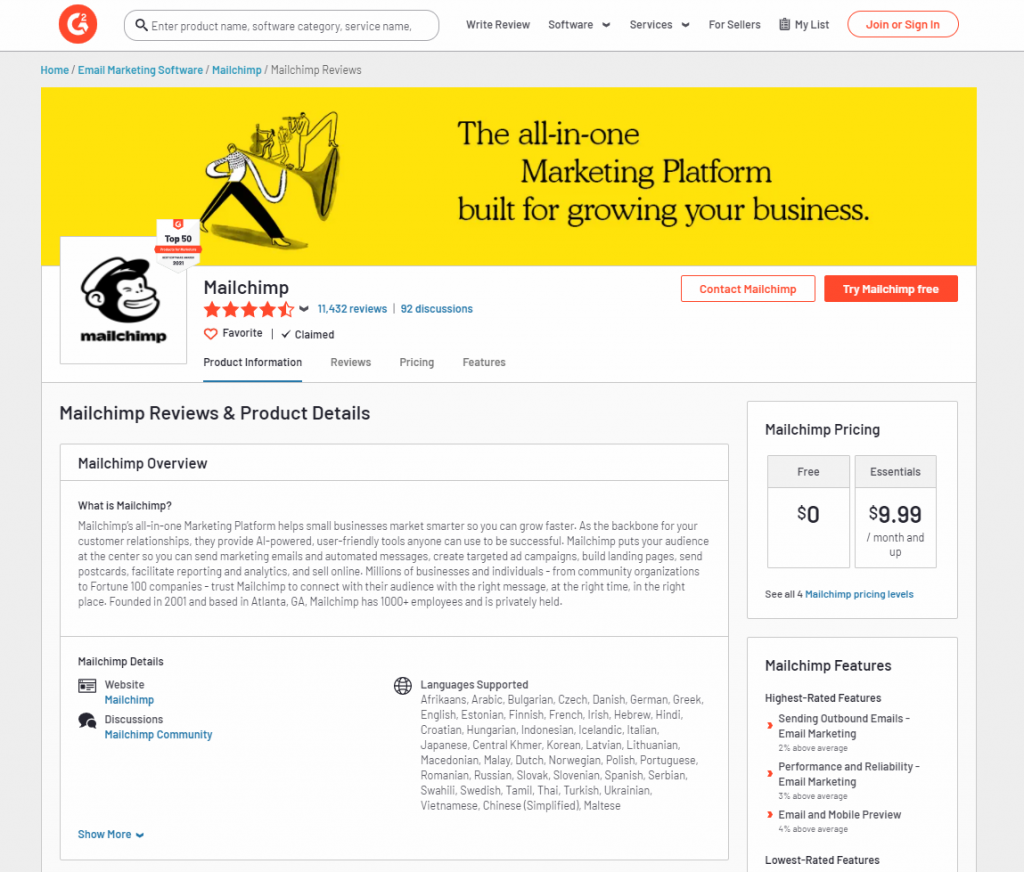
You get to add all the product information, including an overview, main features, pricing, videos, screenshots. The website will verify these details by contacting you directly – it ensures maximum transparency.
If you scroll down, you will see user feedback, either as a video or in a written form. This feedback only comes from verified users, and there is no way you can influence it. The only option is to reply, but not all review websites allow it.
5. Social media marketing
While strategies like free trials, freemiums, demos, and online ads are all viable to bring more SaaS sales, you should not neglect the power of social media.
There is a place for social media networks in your SaaS marketing strategy, without limits on what social platform you can use. Of course, most SaaS marketers use LinkedIn as their number one tool to reach out to potential buyers:
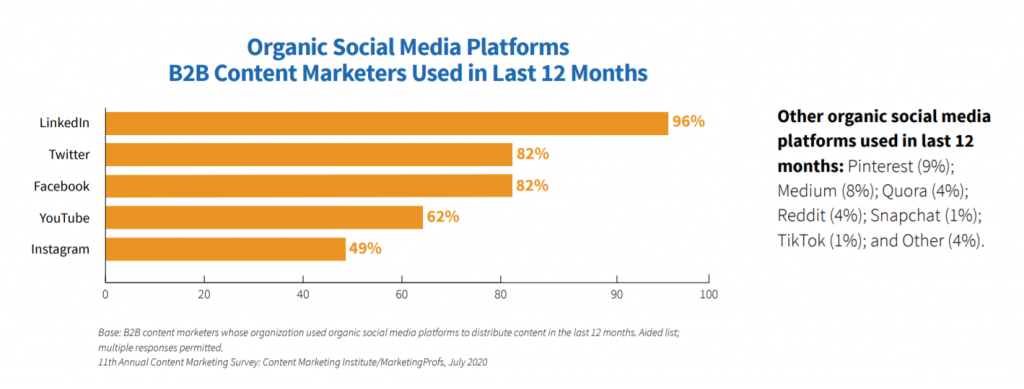
Indeed, LinkedIn has all the tools for you to collect and attract prospects: LinkedIn Small Business, LinkedIn Sales Navigator, Engagement Pods, and so on.
But LinkedIn is more about business, thought leadership, and growing your authority in the industry. And what if you want to show a more fun side of your company?
You can always bet on Instagram. Many SaaS brands use it to show the behind-the-scenes life, give sneak peeks into the working process, and introduce their teams. Take Microsoft, for example. On its Microsoft Life Instagram page, it shares its employees’ stories and pictures from events:
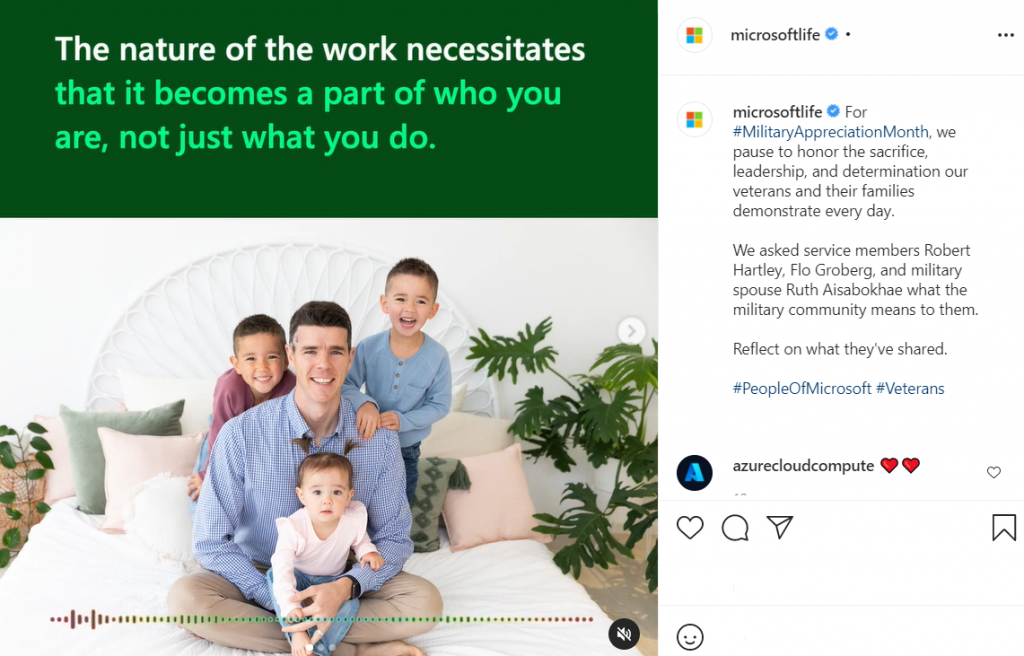
Many brands also create social media presence on Twitter, where they share the latest SaaS industry news and interact with their followers.
6. Blogging
Blogging is one of the most popular growth strategies in digital marketing. Remember we mentioned that information is your biggest asset in SaaS marketing? A blog is the best opportunity for you to share this information, educate, and establish authority in your industry.
But do people still read blogs?
They surely do. A typical B2B buyer will evaluate your blogging strategy to know they can trust you. Besides, adding case studies and other research papers helps build credibility and trust.
If you’re afraid people might find your blog boring, turn it into an educational hub. There is no better example of doing it than HubSpot:

In addition to the blog with guides, solutions, and tips, HubSpot provides learning resources and tools, such as Website Grader, Email Signature Generator, Social Media Calendar, etc. Marketers will find the Make My Persona tool especially useful—it helps you define your ICP, with the demographics, goals, needs, challenges, hobbies, etc.
Inbound Marketing for SaaS
When we talk about SaaS marketing, it’s worth mentioning the role of inbound and outbound strategies. Let’s start with the inbound.
As you may already know from our inbound lead generation article, it aims to attract customers organically or by creating experiences tailored to the needs of your target audience.
Inbound marketing is indispensable for SaaS businesses and brings the following benefits:
- Strategies fit for every budget. Inbound marketing is cost-effective, so if you’re running your company on a shoestring budget, you can still do marketing without having to splurge on expensive lead generation tactics and solutions.
- Stronger relationships with the target audience. Inbound strategies focus on creating organic content that caters to your audience’s needs and, hence, makes you more trustworthy.
- Long-lasting results. Inbound marketing requires your ongoing commitment but also has a lasting effect on brand awareness and recognition.
There’s no shortage of inbound marketing strategies you can employ to generate leads. Here are the most common ones.
1. Content
Essentially, the content will be an omnipresent factor in all marketing strategies, both inbound and outbound. The only difference is the marketing channels you’ll use to distribute it.
If we’re talking about inbound marketing, content can take many forms, from a blog post to visuals and videos. The main goal of such content is to educate and help solve a target customer’s pain points.
But how can you use content to inform about an issue and promote your product simultaneously?
Indeed, promotional pieces are not always received well. One way to avoid criticism (and Google lowering your position in SERPs) is to introduce an issue and present your product as a solution.
Consider Ahrefs as an example. In the article on detecting and deflecting negative SEO attacks, the author briefly mentions how Ahrefs’ tool can help spot link spam that can harm your backlink profile:
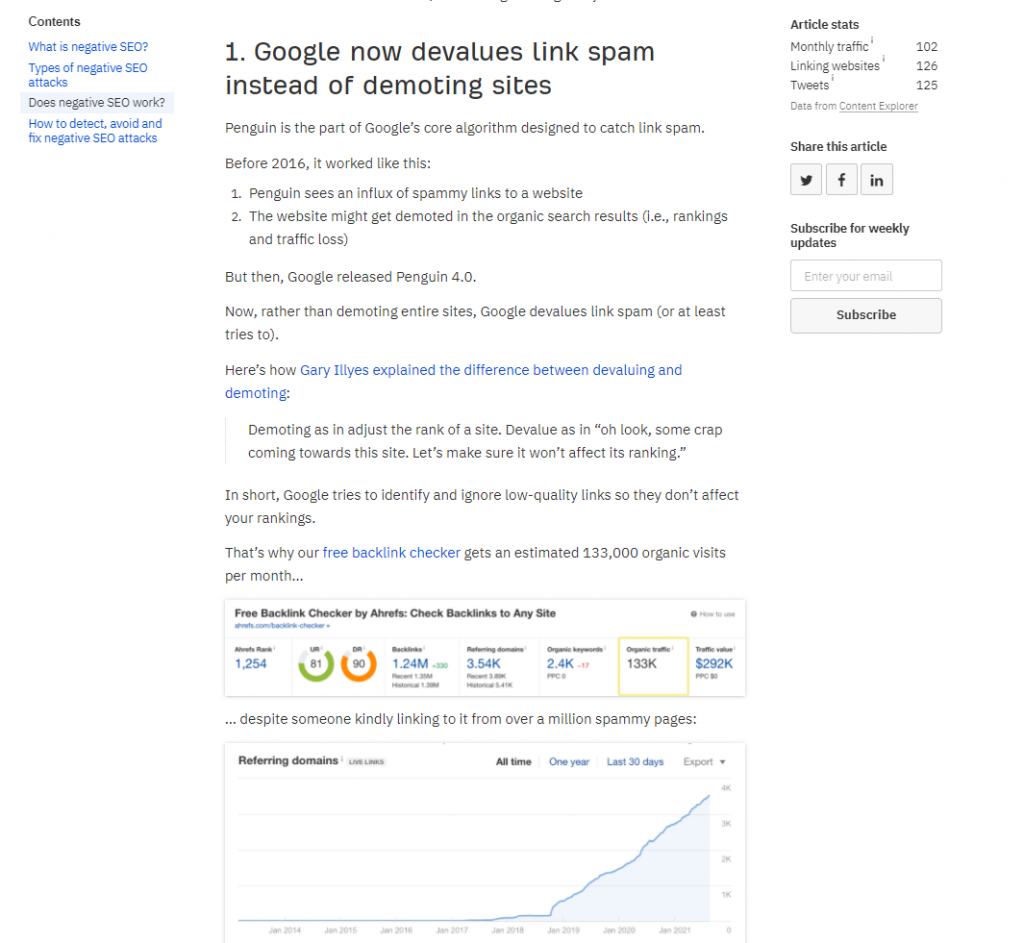
The writer knows that the reader will be looking for a solution to solve this problem and casually throws it in. No harm, no foul.
Here are more content types that help you build authority:
- ebooks
- guides
- case studies
- white papers
- infographics
- research reports
In other words, you can use any content that carries value to generate and nurture leads.
2. Email marketing
Email marketing is one of the most versatile inbound marketing channels for SaaS. It can be of great help on any stage of the lead generation funnel and serve as one of the primary means of communication between a brand and a customer.
If you’re using a free trial to bring more potential buyers, email marketing can help you nurture them. For instance, the following email from Tidio signals the end of the free trial and, to remind of all the product perks and benefits, share the list of the main features and the needs they answer:
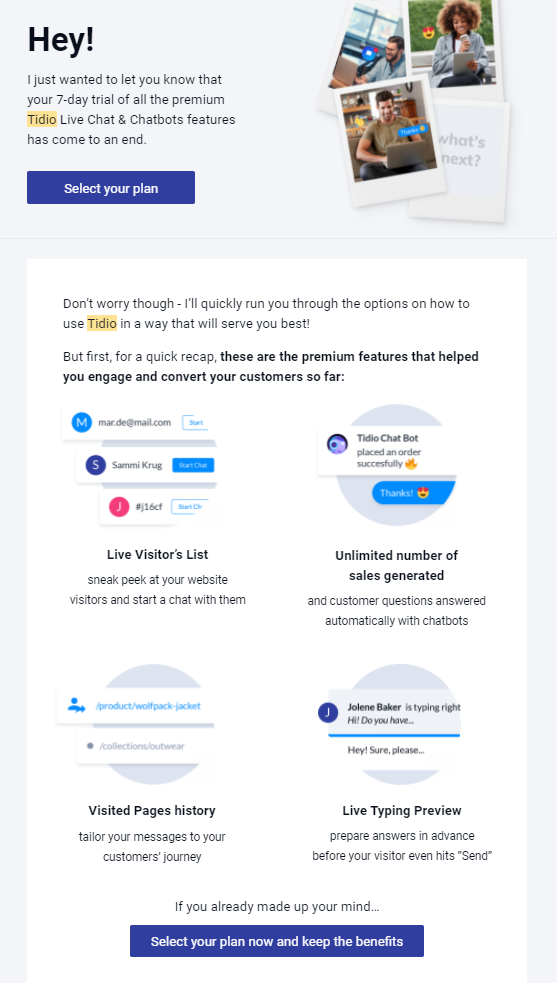
Half of the success of marketing depends on the content. If your email copy targets the right pain point and is distributed at the right time, email marketing will show a positive ROI.
3. Video marketing
As with blog content, you can also tell your story using video. Although video marketing is more cost-intensive, it is likely to deliver more engagement thanks to the visualization of the information.
Video content can also help you improve sales. According to Wyzowl’s State of Video Marketing survey, eight out of ten marketers say videos directly impact revenue. Besides, 29% of respondents use sales metrics to measure a video’s success.
Although we don’t entirely agree that sales growth indicates successful video content, it can be one of the goals to use video marketing. However, the most common reason is, again, to educate, build authority and awareness.
For an example, let’s go back to Ahrefs – the brand’s YouTube channel is a perfect representation of how a SaaS brand can and should build a video marketing strategy:
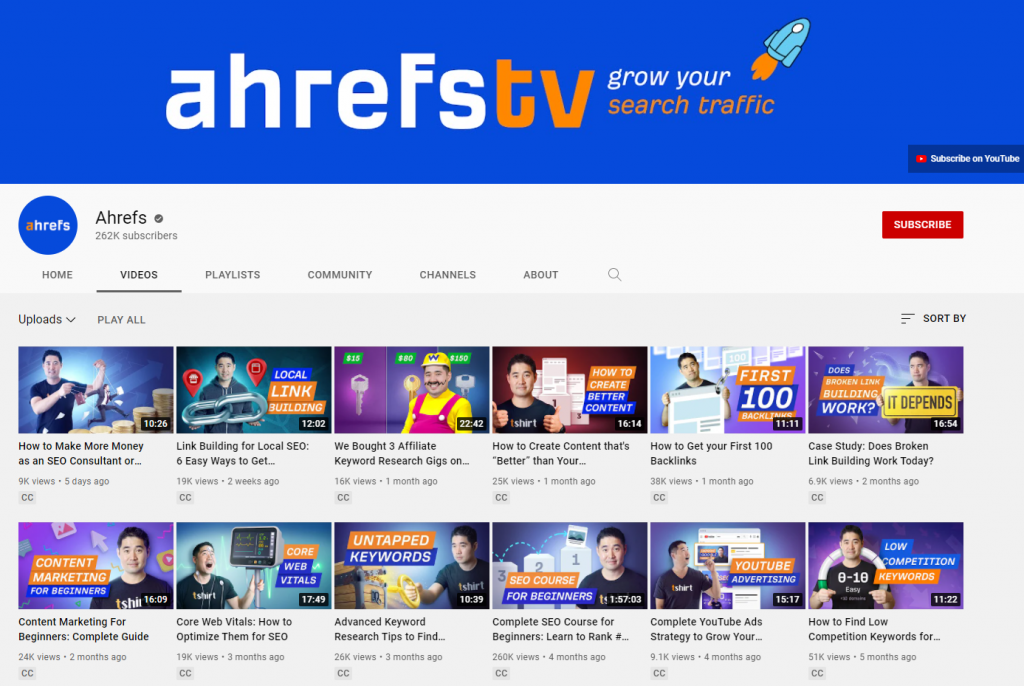
Ahrefs’ channel is a big learning hub with videos that solve certain problems with the help of the brand’s software. In some instances, Ahrefs also features its videos in blog posts mainly to provide an extra learning opportunity.
4. Influencer marketing
Even though influencers might not be your first choice for SaaS marketing, you can still involve it to promote your product. But when we’re talking about software as a service, influencer marketing is more about educating through someone’s expertise rather than having a celebrity talk about your brand.
For instance, you can invite an expert from your industry to have a quick chat about current trends and issues. Another option is to run a workshop or webinar together and answer burning questions live.
If your SaaS business is involved in social causes, it’s also possible to use influencer marketing to attract more public attention to problematic issues. For instance, Salesforce engages with celebrities like Jane Fonda to talk about climate change:
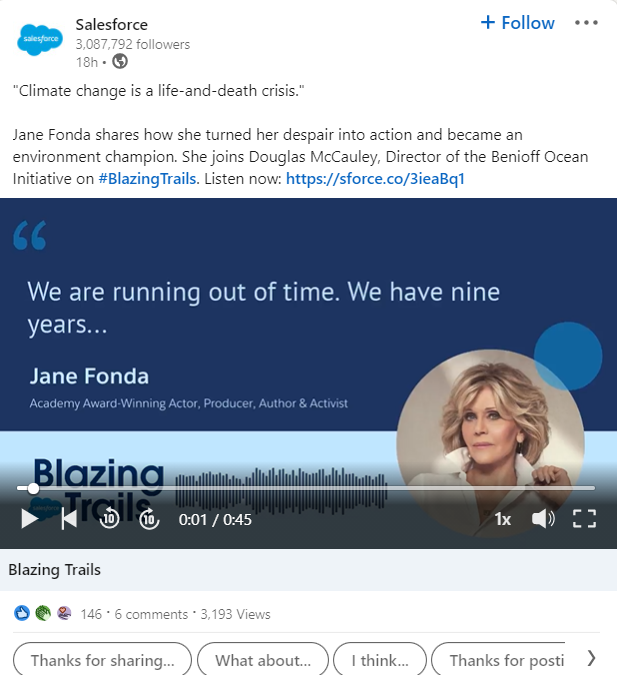
The point behind influencer marketing is getting access to a bigger audience, especially if you’re new to the industry. If an expert introduces you and vouches for your product, you’re guaranteed to get more sales-qualified leads.
So, try to connect with an influencer from your niche with an audience similar to your ICP.
5. SEO
Search engine optimization is not a marketing channel but rather a strategy to ensure the success of some marketing tactics (mostly blogging and everything connected to content).
SEO offers an array of ways to support your online marketing strategy and get your brand noticed. It includes the following components:
- Keyword research
- User intent
- Analytics and reporting
- Crawling and indexing
- Mobile SEO
- Technical SEO
All these SEO components are intertwined and play an equal role in helping your SaaS business get to the top of SERPs. You can also add link building to the mix, as it impacts your content’s visibility and can give a real boost to its performance.
Voice search is another trend that has been gaining momentum in the past few years. Prompted by the rise of smart home assistants, it urges B2B and B2C brands to optimize their content and make it decipherable.
SaaS brands must be familiar with the SEO essentials. Since your marketing strategy relies on sharing information, you should optimize it well for Google to understand the intent and distribute it to a relevant audience.
Outbound Marketing for Saas
Contrary to inbound strategies, outbound marketing serves to popularize a product using more invasive tactics, such as continued promotions, ads, and PR. In our outbound lead generation article, we’ve mentioned that outbound techniques focus on making a hard sell, which most consumers don’t like.
But does it mean there is no place for outbound marketing in your SaaS strategy?
Of course, not. These techniques have quite a few lucrative benefits:
- More sales-qualified leads. Since you are making a sales offer directly to a potential buyer, it is easier to differentiate those that will purchase your product from passers-by.
- Better knowledge of the market. If you’re planning to expand your SaaS business, outbound marketing can help you test the waters before investing in other, more expensive strategies.
- Improved brand awareness. With outbound marketing, you don’t have to wait for your audience to notice your brand – you’re the one spreading the word.
Now, let’s quickly review the essential outbound marketing strategies for SaaS.
1. Paid advertising
As we’ve mentioned, SaaS businesses do quite well with online ads. It can either be a banner ad on the Google Ads partner website or a social media advertisement. Oftentimes SaaS businesses use social networks for advertising open job positions:

LinkedIn is the best social media platform to advertise your offers since it serves primarily the B2B niche. But you can always try your luck on Twitter as well.
Online ads belong to outbound marketing because you target an audience that’s likely to have never heard of you before. It can be both good and problematic – on the one hand, you get a chance to expand the list of potential buyers, but on the other hand, it can take a while until you actually target the right people.
So, make sure you take your time to build the correct ICP and A/B-test your ads. Otherwise, you’ll end up losing a pretty penny.
2. Cold calling
Cold calling is promoting a business via a call to a customer who’s never heard about it. Simple as that – you have a list of contacts and call them one by one, inviting them to buy your product.
There are many ways to build a contact list. The most unusual one is going through out-of-office email replies and fishing out phone numbers – a bit sneaky, but not illegal.
A more common way is to look for prospects via social media. For instance, LinkedIn Sales Navigator can help you collect contacts; all you need to do is set the right specs for your target audience.
So, it’s clear that cold calling (much like online ads and some other outbound marketing techniques) will have the problem of an incorrect IPC. Until you are sure you’re targeting the right prospect, cold calling will hardly bring you any results.
Additionally, you’ll need a persuasive script to hook the potential buyer. For instance, addressing the right need could help you make a sale. Asking whether the prospect is satisfied with your competitor’s product (given that you know they’re using it) can have the same effect.
Finally, call tracking is an essential part of cold calling. It’s crucial for qualifying the leads and identifying those ready to buy.
3. Syndicated content
Outbound marketing and lead generation involve many PR tactics, and syndicating your content is one of them. Essentially, you republish already available content on other websites. The goal is to improve your online visibility.
You can spot syndicated content by the ‘originally published on’ phrase next to the title:
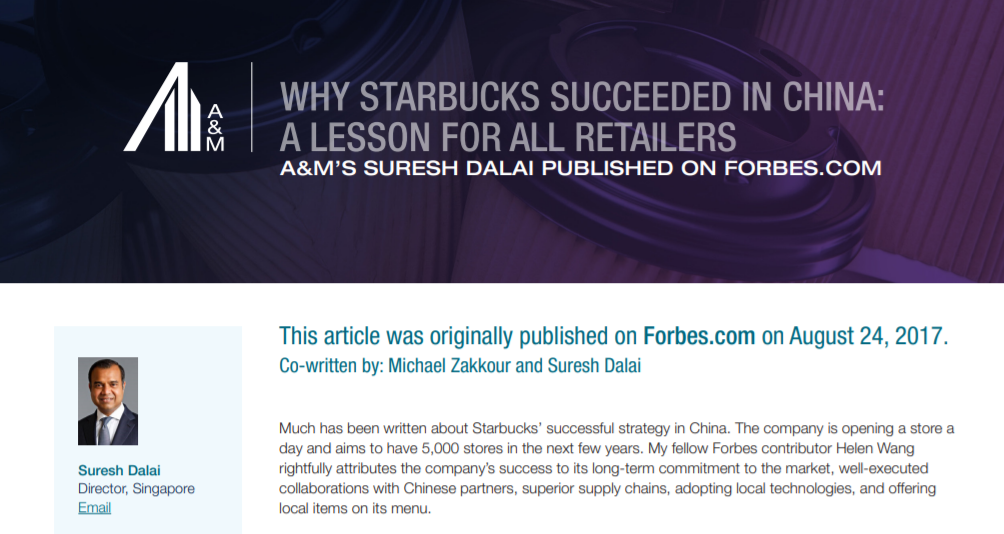
Why content syndication? Can’t you just do guest blogging?
You could, but content syndication is more scalable. If you have a great piece of research and know people will be interested in it, why write something from scratch when you can recycle?
Besides, not every SaaS business can afford to write multiple guest posts a month. Although you could outsource, you should still consider content syndication – it will give you more exposure than a guest article.
With that in mind, try looking for websites that hold authority in your niche. For SaaS businesses, it could be TechCrunch or any review site we previously mentioned.
In terms of content, pick something that has a unique value for your target audience and the website’s readers.
4. Social media outreach
Social media has gifted us another opportunity to find potential prospects. You can involve social media outreach in creating a contact list for cold calling or use it as a standalone strategy.
Social media outreach makes it easier for brands to find relevant buyers. You just need to do a little bit of digging – check out the prospect’s profile information, activity, comments, etc. Then, pick the topic that attracts their attention and gradually introduce your brand and product.
Speaking about that, lack of personalization is one of the most common mistakes in social media outreach. You should take time to learn as much information about each prospect as possible. Tools like LinkedIn Sales Navigator could make the job of finding leads easier, but it’s on you how you approach them.
5. Referral marketing
Last but not least, referral marketing is a way for you to get more leads through referrers, who get some kind of a reward for bringing in new buyers. It’s also an outbound marketing strategy since your referrers reach out to the prospects directly.
Many SaaS businesses run referral programs. For example, Dropbox offers users extra storage space for bringing their friends:
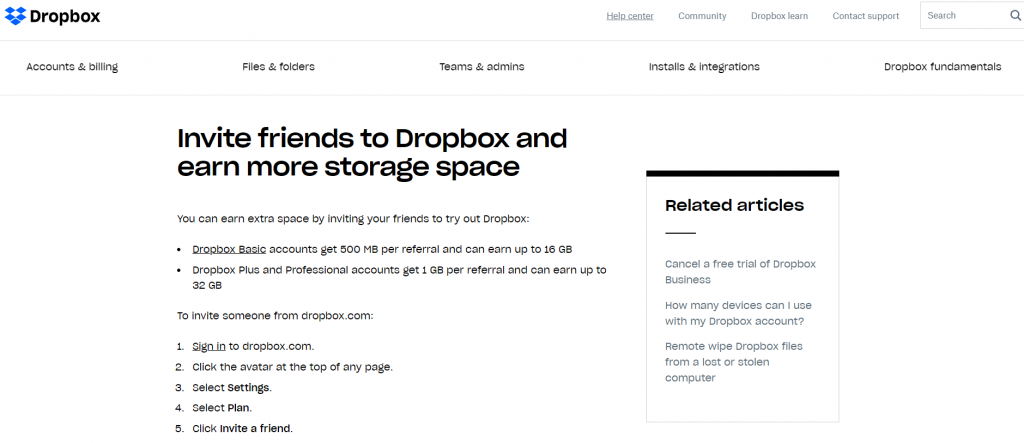
You can also give referrers discount codes and offer people they bring a reward to encourage them to stay with your brand.
Marketing KPIs and metrics for SaaS
We’ve come to one of the most important points – choosing a SaaS marketing KPI and the metrics to track it. The metrics will show your progress and give you insights into improving your efforts.
So, let’s consider the most common SaaS marketing KPIs and the metrics that come along with them.
KPI #1: Lead generation
The goal is clear – you need more people to join the ranks of your target audience. At this point, you can take advantage of both inbound and outbound strategies and use the following metrics to keep up with the progress.
1) Click-through rate (CTR)
A click-through rate is a proportion of people who’ve clicked on your link vs. total measured impressions for a page, lead magnet, or other means you use to attract leads.
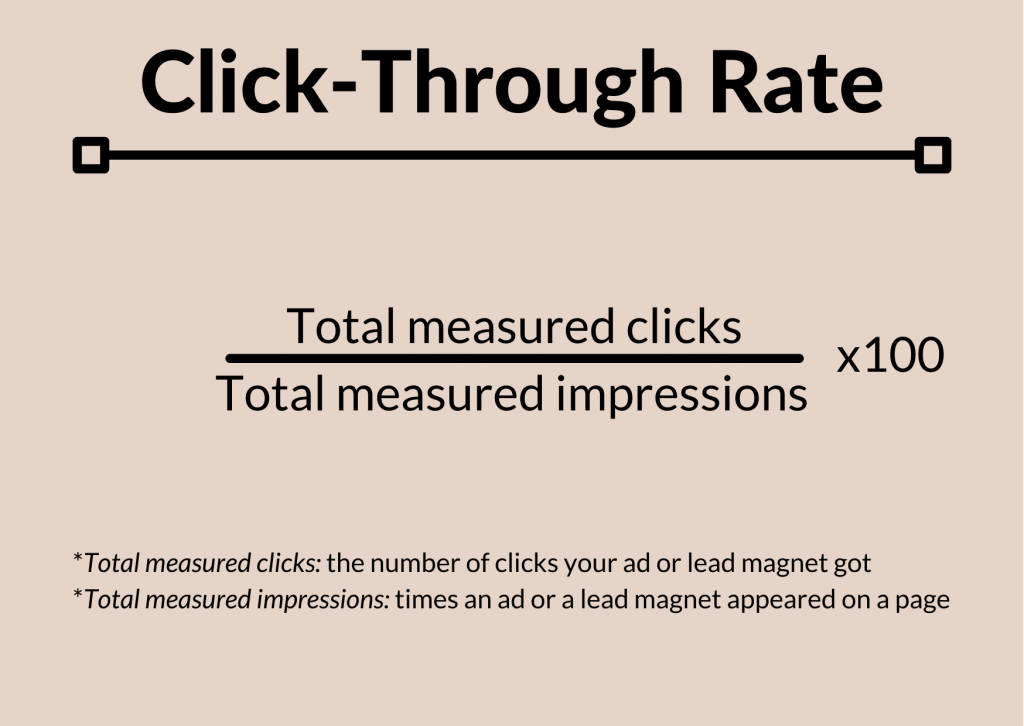
There might be different reasons for a low CTR depending on how you generate leads. For instance, if your online ads are underperforming, you might have addressed the wrong need or didn’t pick the right target audience.
2) Conversion rate
A conversion rate is the percentage of leads that have taken the necessary action (bought your product) out of the total number of visitors or viewers.
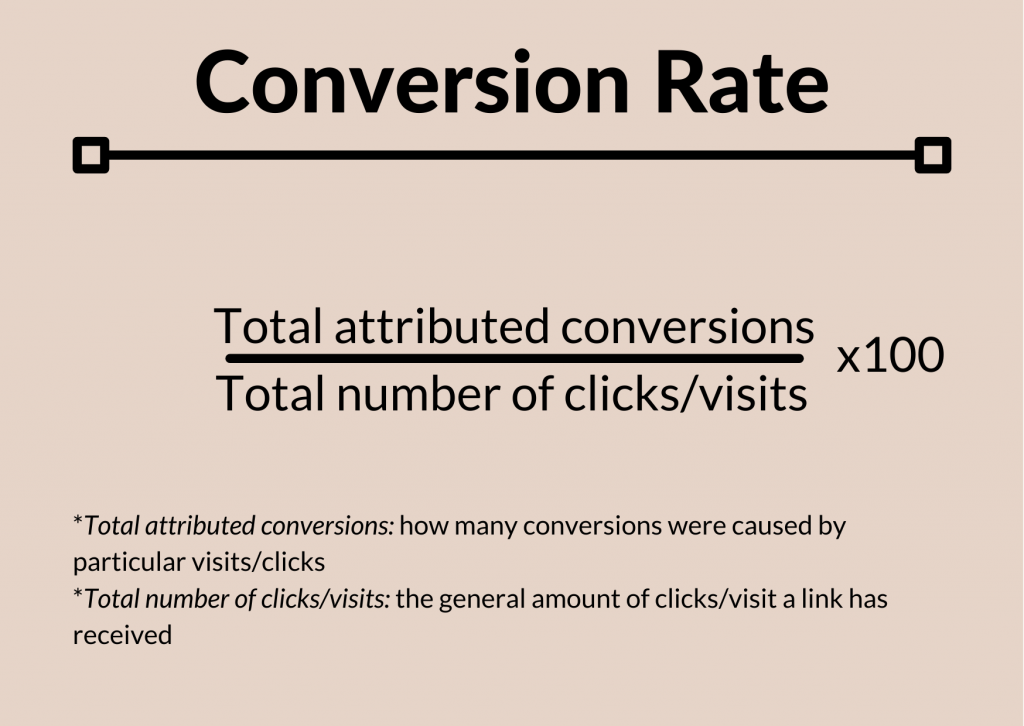
One of the most common reasons for a low conversion rate is a poorly optimized CTA that delivers an unclear message. The copy of a lead magnet also matters and should be tested before applied.
3) Cost per lead
If your SaaS business model depends on ongoing lead generation, then the cost per lead should be one of the key metrics to track. It’s often associated with advertising and reflects how much you spend per each acquired lead.
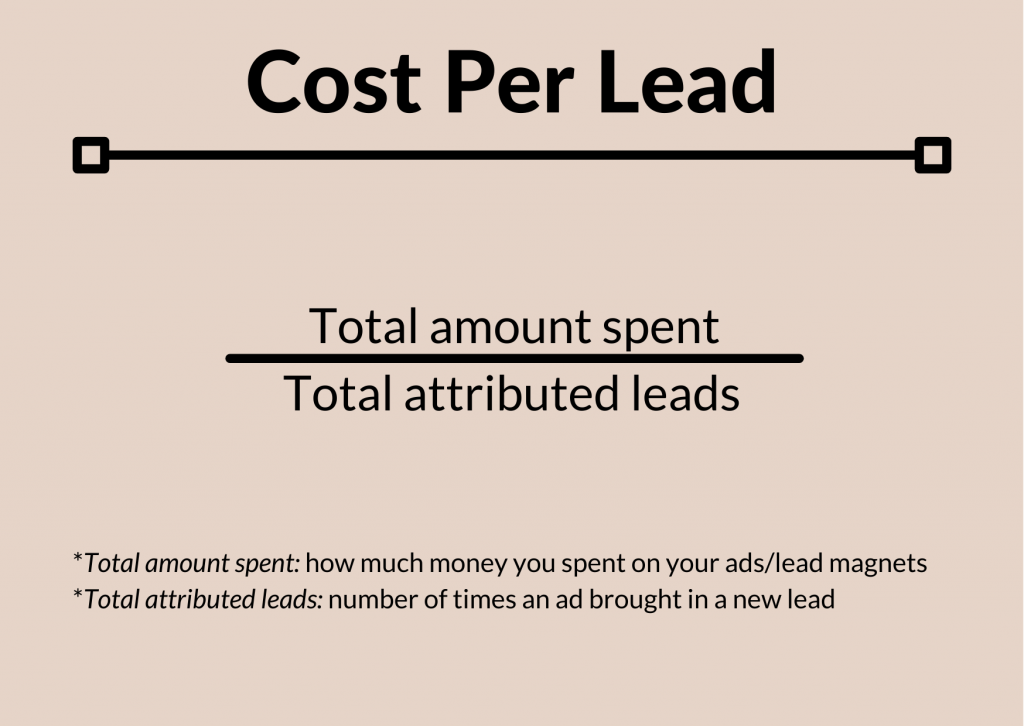
If your cost per lead is getting higher, you might have chosen very competitive keywords for your ad campaign. It’s also possible that you’re getting more impressions but fewer clicks. In both cases, you need to revisit your targeting.
4) Leads per channel
Leads per channel is the number of prospects you’ve acquired from each channel involved in lead generation. This metric indicates whether you’ve picked the right channels to attract more potential buyers.

The image above shows how to calculate the percentage of leads per channel. If the channel doesn’t bring any leads, then it’s simply the wrong one to target.
5) Leads to qualified leads
This metric helps you identify how many qualified leads you get from the overall number of generated prospects. Here’s how you count the percentage:
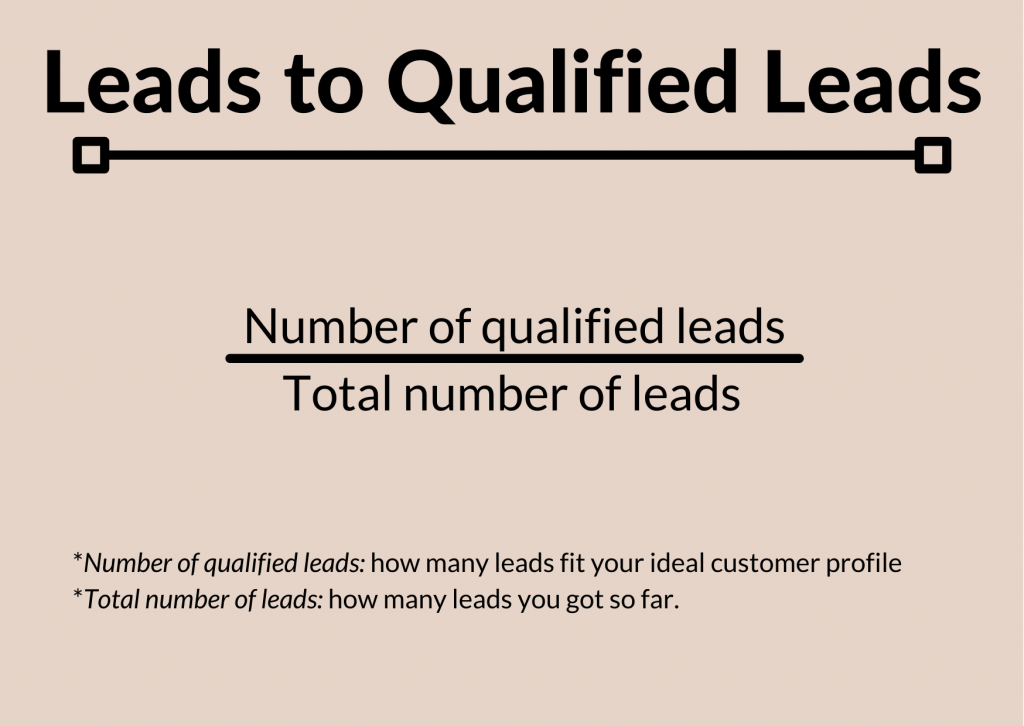
If you don’t get enough qualified leads, you might have chosen the wrong lead magnet, or your copy doesn’t answer your target audience’s pain points.
KPI #2: Traffic
The list of crucial SaaS metrics often includes traffic indicators. If your goal is to increase website and blog visits or track social or referral traffic for respective campaigns, the following metrics should be on your list.
1) Traffic sources
Simply put, traffic sources refer to the ways people find your website or page. There are five common types of traffic sources:
- Organic traffic – via a search engine.
- Direct traffic – doesn’t come through any other channels.
- Referral traffic – from websites that link back to you.
- Paid search traffic – from search ads.
- Social traffic – comes from social media networks.
Google Analytics is the easiest way to review all sources of traffic:

You can find this graph under the Acquisition section in Channels.
2) New vs. returning visitors
This metric shows the proportion of new website visitors vs. the regulars. Google Analytics tracks these visitors with the help of a cookie snippet – if the cookie is present, it’s the returning visitor; if not, it’s a newcomer.
You can find the new vs. returning visitors metric in the Audience section under Behavior:

A low number of new visitors could indicate that your content is hard to find on search engines. Work on SEO and intent to make your content more relevant. A similar reason could point to the low number of returning visitors – people find your content irrelevant or outdated.
3) Average time on site
The next helpful metric for SaaS is the average time on site, or how long a single visitor stays at your website. It is also known as average session duration, and you can find it in the Acquisition section of Google Analytics:
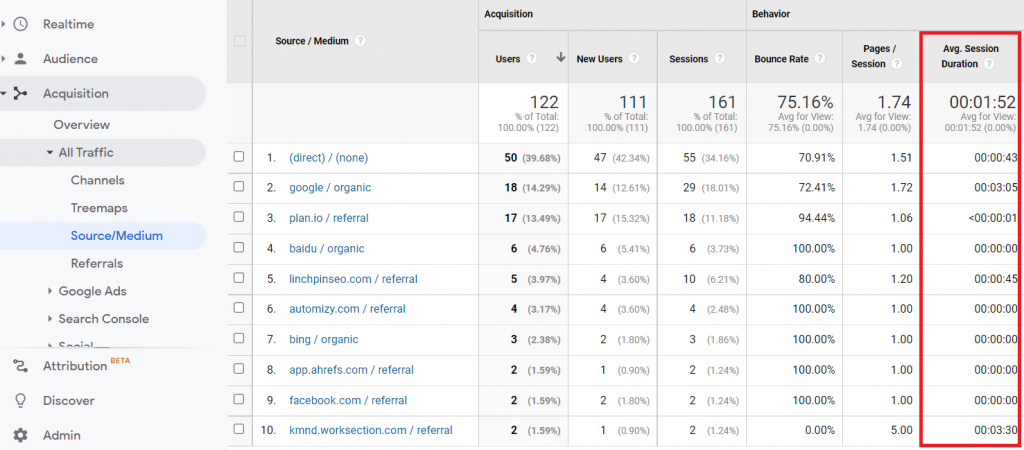
It’s also possible to check out how long visitors stay on each of your website pages on average:
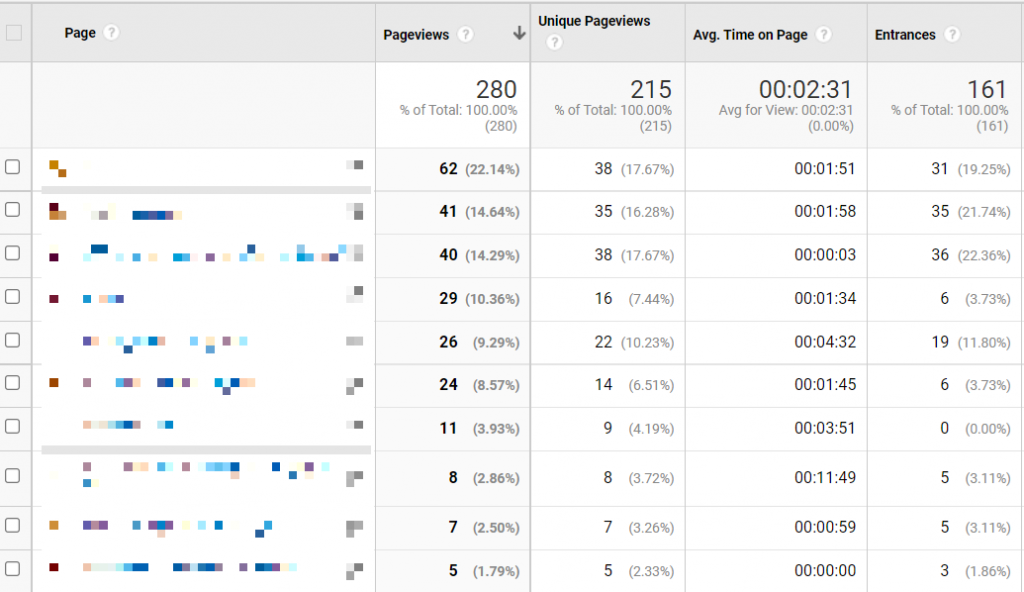
You can find this metric in the Site Content subsection under the Behavior section in Google Analytics.
4) Bounce rate
Bounce rate is the percentage of visitors that leave your website without checking out any other pages. This metric helps analyze the quality of traffic.
Bounce rate is available on Google Analytics in the Site Content section, where you can see the data for every website page:
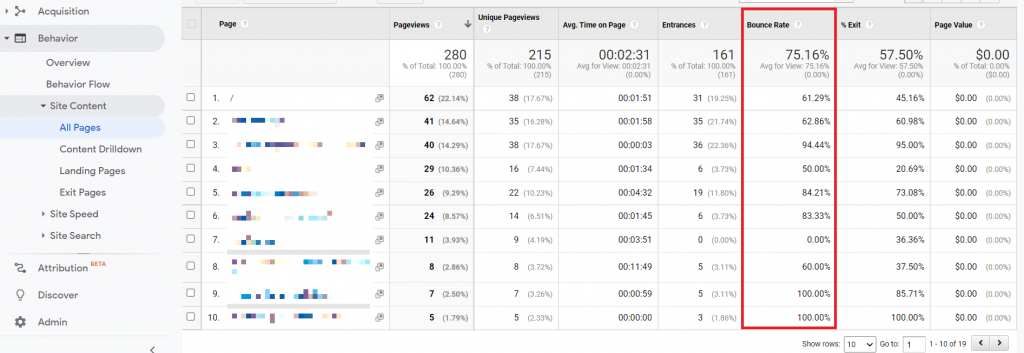
Bounce rate is a fluid metric, and there’s a grey area in its interpretation. For example, a 100% bounce rate doesn’t always show a bad trend in your content strategy – it can happen if your website doesn’t have many content pages yet. Google simply doesn’t have enough information to generate accurate data.
5) Top visited pages
Top visited pages show where the majority of your visitors hang out the most. Google Analytics tanks your most visited pages in the Site Content section under Behavior:
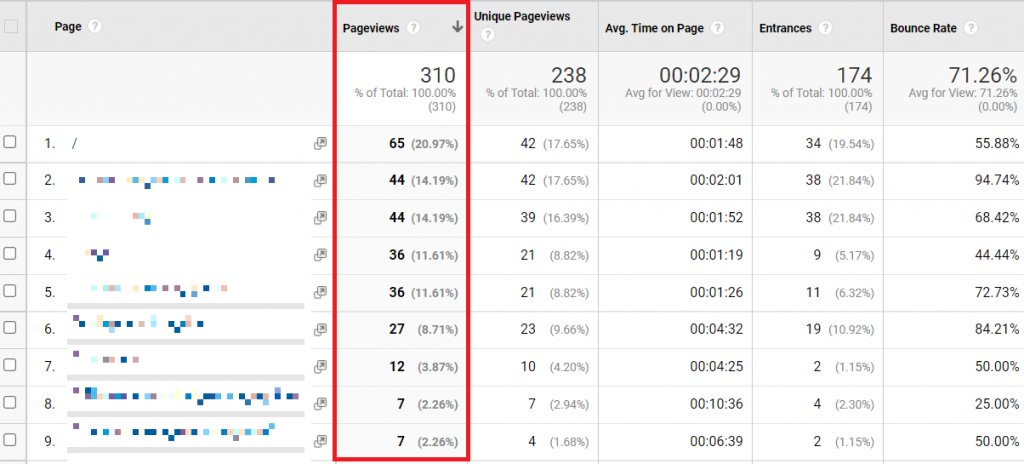
You may find this metric helpful during campaigns involving landing pages or to evaluate the effectiveness of your SEO efforts.
KPI #3: Brand awareness
Tracking brand awareness is as vital for a SaaS business as traffic and lead acquisition. The problem is that none of the metrics directly points to brand awareness. Most of them are somewhat descriptive, but you can still use them to evaluate brand exposure.
1) Total followers
This metric reflects your popularity on social media. If you’re working on content for social media to expand your audience, this metric is an absolute must to follow.
Each social media platform has the Analytics tab, where you can review your current follower count and how many new people subscribed within a given time frame. On LinkedIn, you can also check how many new followers came to you through organic vs. paid channels:
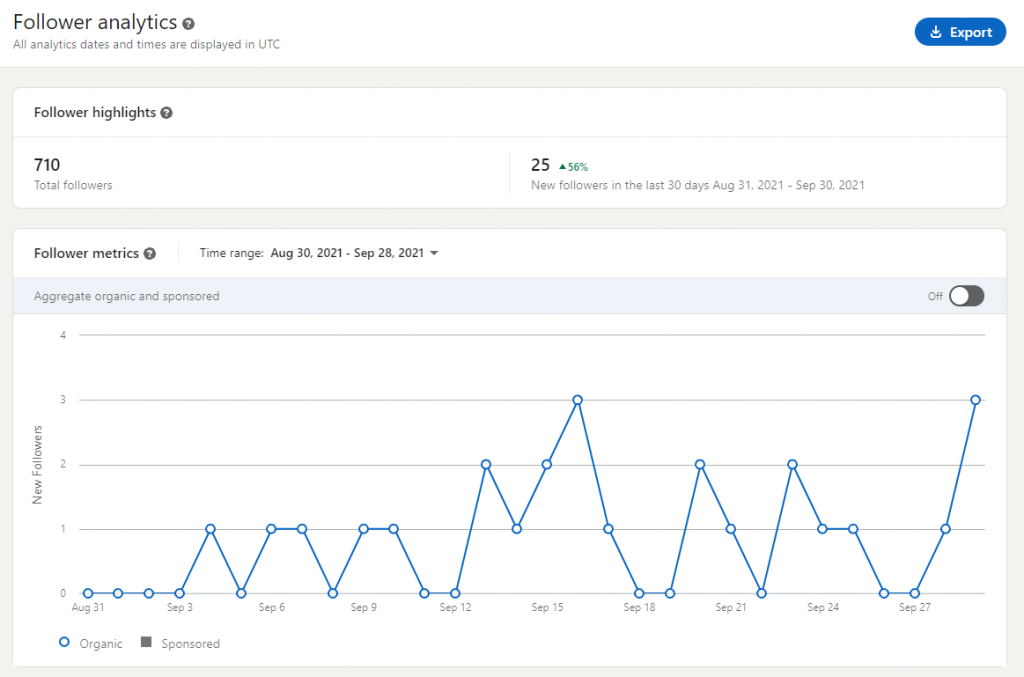
If you’re losing followers, the problem might be behind an inconsistent posting schedule. Make sure you are familiar with the times when your audience is the most active, and adjust your content calendar accordingly.
2) Engagement
Engagement, and engagement rates specifically, is a helpful metric if your content strategy heavily relies on content, whether it’s for your blog or social media. It shows how on-point your content is with your followers’ interests.
On LinkedIn, you can review engagement rates under every post:
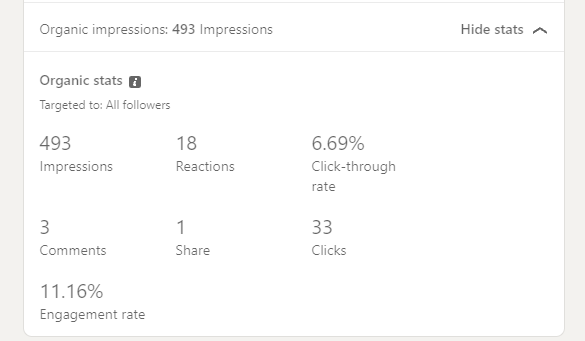
If the engagement rate is low, revisit your content plan and align it with what your audience wants to see.
How?
On Facebook, you can take into account the top-performing content metric. On Twitter, you can also review your audience’s interests. This information can help you come up with more engaging post ideas.
3) Reach
Reach shows the total number of people who’ve seen your content. This metric also applies to online ads.
Where should you look for the data on reach?
For example, on Facebook, you can find it in the respective Insights section:
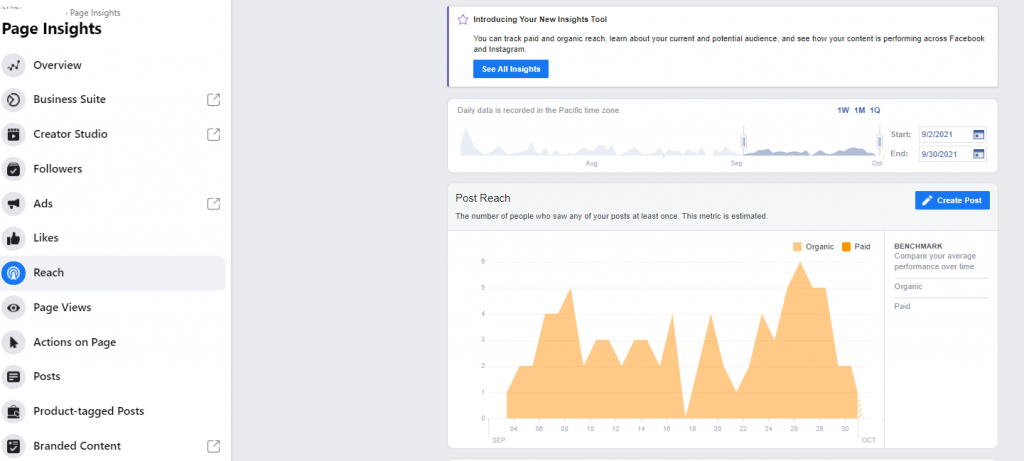
It is also possible to review reach for every post:
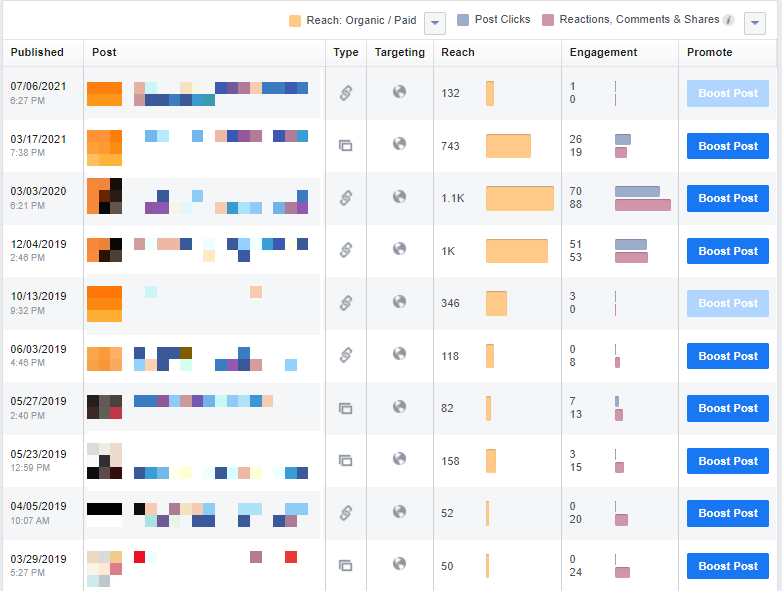
If you’re doing a PPC campaign and your reach is too low, you might need to rework your content or revisit the audience you’ve chosen to target.
4) Impressions
Similar to reach, impressions show how many times your content or ad was displayed on a screen. This metric helps track your ad in real-time.
It’s possible to check impressions through the Analytics Tab of every social media platform. LinkedIn shows impressions per post. On YouTube, you can check impressions for the entire channel and every video:

You can also check out the impressions click-through rate on YouTube, which shows how many people actually watch a video after seeing its thumbnail in the Feed.
5) Referral traffic
Among all SaaS metrics for brand awareness, referral traffic is the most direct. It shows how many people have learned about you via referral campaigns and is indicative of their success.
Referral traffic can be viewed through Google Analytics:

You can also check how many new users referral traffic has brought, which percentage of them is unique, how much time they spend on your website or page, and how fast they bounce.
KPI #4: Paid advertising
As we mentioned, your SaaS business model can greatly benefit from paid advertising. However, a PPC campaign can bring you many problems if you don’t track the metrics in real-time and continuously optimize your ads.
Here are five core metrics you should keep an eye on (obviously, the list can be far more extensive depending on the scale of your advertising campaign).
1) Cost-per-click (CPC)
Also known as pay-per-click, CPC is the price an advertiser pays a publisher each time an ad gets a click. Cost-per-click is determined by the following factors:
- Keyword bids. The formula is simple – if you bid low, your keyword price will be low as well, and vice versa.
- Quality score. It sets the thresholds for first-page bids and directly affects how high your ad can get in SERPs.
- Competition. Some industries (such as e-commerce) are very competitive, which affects the bidding and cost-per-click.
Seasonality also plays a role in determining the cost per click. Although it doesn’t impact SaaS businesses as much as it would an online shop, you should still consider it.
2) Cost per thousand impressions
This metric is similar to CPC and determines the cost for a thousand ad impressions. It’s a method of setting a price for an ad.
However, the term impression is pretty elusive and is often misinterpreted. To avoid that, advertisers often use the notions eCPM and vCPM:
- eCPM. It means an effective cost per mille. This metric considers the actual number of clicks, impressions, and the total cost of the campaign.
- vCPM. This is the cost per a thousand viewable impressions. It focuses only on actual campaign views, disregarding the visitors who have not encountered a campaign. This method prevents fraudulent schemes, such as purchasing impressions.
If CPM is low, it’s not always a good signal. If it comes together with zero conversions, you’re wasting your money, and your ad needs optimization asap.
3) Cost per conversion
Cost-per-conversion is another way of determining an ad price. It determines the cost of acquiring a paying customer. Depending on your goals, a conversion can be a purchase, a filled-out subscription form, watching a video, or any other activity.
This metric is very easy to calculate: if you’ve paid $40 for 40 ad views and generated four customers, the cost is $10 per conversion. The higher your conversion rate, the lower the cost per conversion will be.
4) Lifetime value (LTV)
Lifetime value reflects the revenue a business gets from a single customer throughout their relationship. It shows how the quality of user experience your SaaS business delivers and hints at what needs to be done to improve it.
The lifetime value metric is typically calculated along with average order value and purchase frequency. This is a great way to track the quality of conversions. You can also track the lifetime return on ad spend to evaluate whether your advertising efforts bring long-term results.
5) Return on advertising spend (ROAS)
ROAS is the sum of money gained from ads divided by the total amount spent on ads, multiplied by a hundred. It helps evaluate the overall effectiveness of your advertising campaign.
How much ROAS is good?
It depends on the industry. An average benchmark is 4:1, which is also a good number for SaaS. But, as your business grows, you’ll need a higher benchmark to stay profitable.
4 Common SaaS Marketing Mistakes
Building a working SaaS marketing strategy can be a real challenge and often takes continuous testing until you reach a result that brings good ROI. Besides, learning from your own mistakes can be pretty costly.
So, to save you time and money, here are the four most common SaaS marketing mistakes.
1. Not using social media channels
Some industries aren’t as active on social media channels as others. For example, manufacturing businesses don’t share much on social platforms. It could be because they are trying to protect the technologies they’re using. Yet, it doesn’t stop Toyota from sharing the sneak peeks of the car manufacturing process on Instagram:

SaaS businesses can thrive on social media in many different ways. You can share your expert opinion on LinkedIn, quick news updates on Twitter, and show the behind-the-scenes company life on Instagram. Brands like Microsoft and Salesforce are doing it already, which brings them extra exposure and contributes to their popularity.
2. Disregarding marketing automation
It might be better to control all the marketing processes yourself, but you will find it counterproductive after a while. As your SaaS business grows, you will have to collect and analyze more and more marketing data, which, at one point, you will find impossible to handle by hand.
That’s why it is vital to invest in marketing automation – it can solve many problems along the way. For instance, if tracking the metrics and mining the analytical data is not your strongest suit, you can use Hootsuite or similar services to do it for you. This way, you’ll get helpful marketing insights without breaking a sweat.
3. Forgetting about SEO
Disregarding SEO in the modern world of digital marketing is a sin. SEO should be on the list of must-do marketing activities if you want to get people genuinely interested in your brand.
On the other hand, SEO can be rather complex, and if you don’t fully understand how it functions, it is better to hire someone who does. After all, you’ll have to stay in the know of the latest algorithm updates and constantly work on your SEO strategy to bring proper results.
4. Underestimating online ads
Many marketers say you should bet on organic traffic and SEO more, naming it the best way to acquire loyal customers. But, as we mentioned, outbound strategies can be as good as inbound if you play your cards right. So, it doesn’t mean you should give up on online ads.
However, keep in mind that online ads only bring a temporary spike in traffic. It can temporarily contribute to online exposure, so you should combine it with organic strategies for a better result.
Over to You
Phew! That was a lot of information, huh?
Indeed, SaaS marketing is complex and multifaceted, but it’s definitely not something you can’t do. Just make sure you have a team from the beginning that understands the importance of marketing for SaaS and can tailor your strategy to the brand values and needs of your target audience.
If you haven’t got a chance to read the full article, here’s a quick recap:
- SaaS marketing focuses on strategies aimed at improving brand awareness around the software.
- A SaaS business needs marketing to get more exposure, attract qualified leads, and improve sales.
- The top SaaS marketing strategies involve free trials, freemiums, product demos, PPC campaigns, publications on SaaS review sites, social media marketing, and blogging.
- A SaaS company can benefit from both inbound and outbound marketing and lead generation.
- You can encounter the following SaaS marketing mistakes along the way: disregarding social media, not taking SEO into account, not using marketing automation, and underestimating online ads.

Mariia is a content strategist and editor at Digital Marketer’s World. She is passionate about educating others on all things marketing and believes in the power of the written word.




